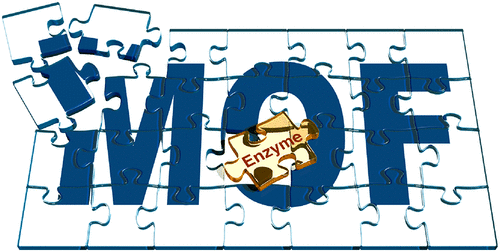当前位置:
X-MOL 学术
›
ACS Cent. Sci.
›
论文详情
Our official English website, www.x-mol.net, welcomes your
feedback! (Note: you will need to create a separate account there.)
Metal–Organic Frameworks for Enzyme Immobilization: Beyond Host Matrix Materials
ACS Central Science ( IF 12.7 ) Pub Date : 2020-08-27 , DOI: 10.1021/acscentsci.0c00687 Xiaoliang Wang 1 , Pui Ching Lan 2 , Shengqian Ma 1, 2
ACS Central Science ( IF 12.7 ) Pub Date : 2020-08-27 , DOI: 10.1021/acscentsci.0c00687 Xiaoliang Wang 1 , Pui Ching Lan 2 , Shengqian Ma 1, 2
Affiliation

|
Enzyme immobilization in metal–organic frameworks (MOFs) as a promising strategy is attracting the interest of scientists from different disciplines with the expansion of MOFs’ development. Different from other traditional host materials, their unique strengths of high surface areas, large yet adjustable pore sizes, functionalizable pore walls, and diverse architectures make MOFs an ideal platform to investigate hosted enzymes, which is critical to the industrial and commercial process. In addition to the protective function of MOFs, the extensive roles of MOFs in the enzyme immobilization are being well-explored by making full use of their remarkable properties like well-defined structure, high porosity, and tunable functionality. Such development shifts the focus from the exploration of immobilization strategies toward functionalization. Meanwhile, this would undoubtedly contribute to a better understanding of enzymes in regards to the structural transformation after being hosted in a confinement environment, particularly to the orientation and conformation change as well as the interplay between enzyme and matrix MOFs. In this Outlook, we target a comprehensive review of the role diversities of the host matrix MOF based on the current enzyme immobilization research, along with proposing an outlook toward the future development of this field, including the representatives of potential techniques and methodologies being capable of studying the hosted enzymes.
中文翻译:

固定化酶的金属有机框架:宿主基质材料之外
随着有机金属框架的发展,将酶固定在金属有机框架(MOF)中作为一种有前途的策略正吸引着来自不同学科的科学家的兴趣。与其他传统宿主材料不同,MOF具有独特的高表面积,大而可调节的孔径,可功能化的孔壁以及多种结构的优势,使其成为研究宿主酶的理想平台,这对工业和商业生产过程至关重要。除了具有MOF的保护功能外,MOF在酶固定化中的广泛作用还可以通过充分利用其非凡的特性(如结构明确,孔隙率高和可调功能)而得到很好的利用。这种发展将重点从固定化策略的探索转移到了功能化。同时,毫无疑问,这将有助于更好地了解酶,使其在封闭环境中宿主后的结构转化,特别是方向和构象变化以及酶与基质MOF之间的相互作用。在本《展望》中,我们基于当前的酶固定化研究目标,对宿主基质MOF的作用多样性进行全面综述,并提出对该领域未来发展的展望,包括能够实现这一目标的潜在技术和方法的代表。研究宿主酶。特别是在方向和构象变化以及酶与基质MOF之间的相互作用方面。在本《展望》中,我们基于当前的酶固定化研究目标,对宿主基质MOF的作用多样性进行全面综述,并提出对该领域未来发展的展望,包括能够实现这一目标的潜在技术和方法的代表。研究宿主酶。特别是在方向和构象变化以及酶与基质MOF之间的相互作用方面。在本《展望》中,我们基于当前的酶固定化研究目标,对宿主基质MOF的作用多样性进行全面综述,并提出对该领域未来发展的展望,包括能够实现这一目标的潜在技术和方法的代表。研究宿主酶。
更新日期:2020-09-23
中文翻译:

固定化酶的金属有机框架:宿主基质材料之外
随着有机金属框架的发展,将酶固定在金属有机框架(MOF)中作为一种有前途的策略正吸引着来自不同学科的科学家的兴趣。与其他传统宿主材料不同,MOF具有独特的高表面积,大而可调节的孔径,可功能化的孔壁以及多种结构的优势,使其成为研究宿主酶的理想平台,这对工业和商业生产过程至关重要。除了具有MOF的保护功能外,MOF在酶固定化中的广泛作用还可以通过充分利用其非凡的特性(如结构明确,孔隙率高和可调功能)而得到很好的利用。这种发展将重点从固定化策略的探索转移到了功能化。同时,毫无疑问,这将有助于更好地了解酶,使其在封闭环境中宿主后的结构转化,特别是方向和构象变化以及酶与基质MOF之间的相互作用。在本《展望》中,我们基于当前的酶固定化研究目标,对宿主基质MOF的作用多样性进行全面综述,并提出对该领域未来发展的展望,包括能够实现这一目标的潜在技术和方法的代表。研究宿主酶。特别是在方向和构象变化以及酶与基质MOF之间的相互作用方面。在本《展望》中,我们基于当前的酶固定化研究目标,对宿主基质MOF的作用多样性进行全面综述,并提出对该领域未来发展的展望,包括能够实现这一目标的潜在技术和方法的代表。研究宿主酶。特别是在方向和构象变化以及酶与基质MOF之间的相互作用方面。在本《展望》中,我们基于当前的酶固定化研究目标,对宿主基质MOF的作用多样性进行全面综述,并提出对该领域未来发展的展望,包括能够实现这一目标的潜在技术和方法的代表。研究宿主酶。











































 京公网安备 11010802027423号
京公网安备 11010802027423号